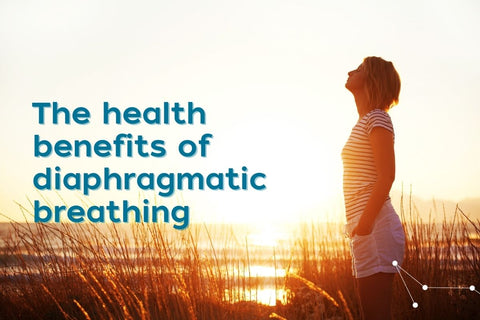What is Diaphragmatic Breathing (DB)?
Breathing is an automated process that helps facilitate the exchange of gases especially carbon dioxide and oxygen. On average, most people breathe between 12-20 cycles per minute. Breathing at a slow pace involves deliberately slowing down the breath rate close to 6 cycles per minute. Deep breathing (or diaphragmatic breathing) has been used in ancient eastern religions, like Buddhism, in practices of martial arts, yoga, Tai Chi Chuan and meditation, and is thought to contribute to social adaptation and emotional balance.
Systematic reviews have reported mind-body exercises like yoga or tai chi can reduce stress in individuals with negative emotions or under high stress by modulating the sympathetic-vagal balance. DB in athletes has also been reported to increase antioxidant activity and reduce oxidative stress after exercise. Some psychological studies have shown diaphragmatic breathing practices are an effective non-pharmacological intervention to assist in reducing anxiety, depression and stress.
Breath-based meditation techniques that utilise rhythmic breathing to attain a deep meditative and relaxed state are thought to optimize human performance, contributing to improved cognitive performance, tissue perfusion, glucose metabolism, lowered blood pressure, and enhanced immune system function.
DB can be defined as an integrative mind-body training technique that involves contraction of the diaphragm, expansion of the belly and a lengthening of both the inhalation and exhalation process. Studies that have examined the physiological effects of breathing interventions report a shared physiological basis that underlie cognition, breathing and emotion involving the autonomic nervous system (ANS).
Evidence shows that even a single episode of deep breathing practice can significantly decrease blood pressure and increase heart rate variability (HRV) (a measurement of the variation in time between each heartbeat). Higher HRV has been found to be associated with reduced morbidity and mortality, and improved psychological wellbeing and quality of life.
Autonomic Nervous System (ANS)
The autonomic nervous system is a part of the peripheral nervous system that regulates involuntary functions of the body including heart rate, blood pressure, respiration, digestion and sexual arousal. It can be subdivided into three anatomically distinct divisions: the sympathetic nervous system (SNS), the parasympathetic nervous system (PSNS) and the enteric nervous system (ENS).
The SNS has important effects for example sweating in response to changes in temperature and reflex adjustments to the cardiovascular system, including increases in heart rate and cardiac output. It is our ‘fight or flight’ response under conditions of stress. Activation of the SNS has a direct influence on increasing heart rate, cardiac output, skeletal muscle blood flow, pupillary dilation, bronchial dilation, and gastrointestinal vasoconstriction (reducing blood flow to the gastrointestinal tract). This basically prepares our body to react to imminent danger.
Whilst this might be beneficial if we were being chased by a lion (not that being chased by a lion is beneficial by any means), chronic (long-term) stress-induced secretion of adrenaline and cortisol can result in increased blood pressure leading to cardiovascular disease and hyperglycaemia (high blood glucose levels) which can result in type 2 diabetes, and increase the risk of death due to heart attack and stroke.
The PSNS is the opposite of the SNS. It is responsible for our body’s rest and digest response, bringing the body back to a restful state of homeostasis. The PSNS controls the majority of the bodily functions during a restful state. The vagus nerve (VN) is the main effector of the PSNS, meaning it helps to relay relaxation from the CNS to the body and checks in on any arousal and states of homeostasis.
The activity of the VN is modulated by respiration. During inhalation it is suppressed and during exhalation and slow respiration cycles it is activated, meaning that breathing exercises can have a direct effect on regulating the effects of the vagus nerve on the PSNS and can have important effects on both mental and physical health.
Cardiovascular / Respiratory system benefits
Cardiac Vagal Activity (CVA), refers to the activity of the vagus nerve regulating the function of the cardiovascular system. Increasing the duration of exhalation slightly longer than inhalation promotes an increase in CVA as the vagus nerve is activated during exhalation. Slow breathing has also been shown to reduce blood pressure and heart rate, helping to activate the parasympathetic nervous system (PSNS) via reduced respiratory rate (RR).
Heart rate will naturally increase during inspiration and decrease during expiration while the arterial blood pressure lowers. DB is therefore capable of suppressing blood pressure and heart rate by slowing down breathing and diaphragm excursions.
The diaphragm is the major respiratory muscle, increased use of which has a positive correlation with lung volume. If used consciously during respiration, the diaphragm can increase lung capacity. In individuals with Chronic Obstructive Pulmonary Disease (COPD), breathing exercises have shown to improve respiratory reserve, tidal volume, respiratory time and Quality of Life (QoL). Controlled respiratory rate used in DB has also been shown to improve blood oxygen levels.
Improvements in sleep
As we all know, sleep is an essential part of life during which numerous important homeostatic functions occur. Sleep is largely regulated by the ANS, which is integral to the initiation of and maintenance of sleep. Compared to prehistoric times, our ‘fight or flight’ response is chronically elevated, potentially due to a combination of distress from our jobs, commitment to goals and responsibilities, current world climate and sleep deprivation.
The parasympathetic activation effects of diaphragmatic breathing has been shown to have positive influences on sleep quality and duration and has been used to assist in treating patients who suffer from insomnia. Research suggests that deep breathing techniques may assist in the natural production of melatonin which can help promote parasympathetic tone and promote a state of relaxation.
How to perform diaphragmatic breathing:
- Either sit or lie in a comfortable position
- Ensure your shoulders are relaxed
- Place one hand on your chest and the other on your stomach
- Begin breathing in slowly through your nose for six seconds. You should feel the air move through your nose, expanding your abdomen. You are wanting your stomach to move outwards whilst your chest remains relatively still.
- Next, exhale slowly for six seconds, whilst gently pressing on your stomach with your hand. Purse your lips as if you were about to drink out of a straw.
- Repeat several times
References:
- Carter, K. S., & Carter, R., 3rd (2016). Breath-based meditation: A mechanism to restore the physiological and cognitive reserves for optimal human performance. World journal of clinical cases, 4(4), 99–102. https://doi.org/10.12998/wjcc.v4.i4.99
- Gerritsen, R., & Band, G. (2018). Breath of Life: The Respiratory Vagal Stimulation Model of Contemplative Activity. Frontiers in human neuroscience, 12, 397. https://doi.org/10.3389/fnhum.2018.00397
- Hamasaki H. (2020). Effects of Diaphragmatic Breathing on Health: A Narrative Review. Medicines (Basel, Switzerland), 7(10), 65. https://doi.org/10.3390/medicines7100065
- Jerath, R., Beveridge, C., & Barnes, V. A. (2019). Self-Regulation of Breathing as an Adjunctive Treatment of Insomnia. Frontiers in psychiatry, 9, 780. https://doi.org/10.3389/fpsyt.2018.00780
- Ma, X., Yue, Z. Q., Gong, Z. Q., Zhang, H., Duan, N. Y., Shi, Y. T., Wei, G. X., & Li, Y. F. (2017). The Effect of Diaphragmatic Breathing on Attention, Negative Affect and Stress in Healthy Adults. Frontiers in psychology, 8, 874. https://doi.org/10.3389/fpsyg.2017.00874
- Russo, M. A., Santarelli, D. M., & O'Rourke, D. (2017). The physiological effects of slow breathing in the healthy human. Breathe (Sheffield, England), 13(4), 298–309. https://doi.org/10.1183/20734735.009817
- Zaccaro, A., Piarulli, A., Laurino, M., Garbella, E., Menicucci, D., Neri, B., &Gemignani, A. (2018). How Breath-Control Can Change Your Life: A Systematic Review on Psycho-Physiological Correlates of Slow Breathing. Frontiers in human neuroscience, 12, 353. https://doi.org/10.3389/fnhum.2018.00353


